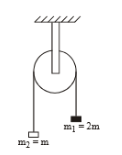The moment of inertia of pulley is I and its radius is R. The string doesn't slips on the pulley, as system is released, the acceleration of the system is
 \(\)
\(\)
1.
2.
3.
4.
 \(\)
\(\)
In uniform circular motion
1. Both the angular velocity and the angular momentum vary
2. The angular velocity varies but the angular momentum remains constant
3. Both the angular velocity and the angular momentum stay constant
4. The angular momentum varies but the angular velocity remains constant
1. \(1\)
2. \(2\)
3. \(3\)
4. \(4\)
A particle of mass m moving with velocity u makes an elastic one-dimensional collision with a stationary particle of mass m. They are in contact for a very short time T. Their force of interaction increases from zero to F0 linearly in time T/2 and decreases linearly to zero in further time T/2. The magnitude of F0 is:
1. mu/T
2. 2mu/T
3. mu/2T
4. None of these
A force of 50 dynes is acted on a body of mass 5 g which acts for an interval of 3 seconds, then impulse is
1. 0.15 × 10–3 N-s
2. 0.98 × 10–3 N-s
3. 1.5 × 10–3 N-s
4. 2.5 × 10–3 N-s

1. \(\frac{3g}{2L}\)
2. \(\frac{3g}{\sqrt{2}L}\)
3. \(\frac{3g}{2\sqrt{2}L}\)
4. \(\frac{6g}{\sqrt{2}L}\)
A body of mass m slides down an incline and reaches the bottom with a velocity v. If the same mass were in the form of a ring which rolls down this incline, the velocity of the ring at bottom would have been
1. v
2.
3.
4.
In an explosion a body breaks up into two pieces of unequal masses. In this
(1) Both parts will have numerically equal momentum
(2) Lighter part will have more momentum
(3) Heavier part will have more momentum
(4) Both parts will have equal kinetic energy
Two bodies of masses m1 and m2 have equal kinetic energies. If p1 and p2 are their respective momentum, then ratio p1 : p2 is equal to
(1)
(2)
(3)
(4)
A light and a heavy body have equal momenta. Which one has greater K.E
(1) The light body
(2) The heavy body
(3) The K.E. are equal
(4) Data is incomplete







